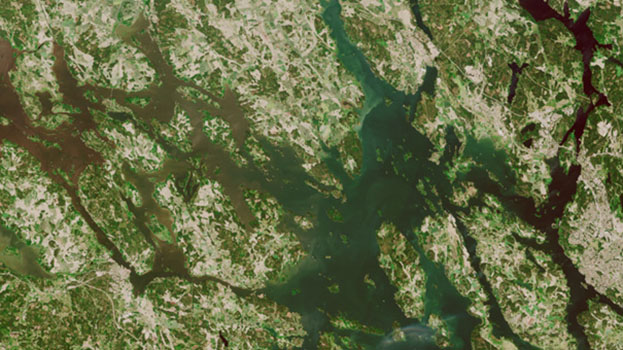EO4WFD
Satellite-based freshwater indicators in support of the Swedish Water Framework Directive
Overview
Context
Swedish and European legislation requires documentation of natural habitats and the majority of international, national and regional agreements, directives and management plans aim to protect and monitor freshwater habitats to ensure sustainable management of these ecosystems and to assess the spatial distribution of the most sensitive and essential habitats which require long-term protection.
A fundamental part of the national work on freshwater is to assess the status and monitor temporal changes to ensure a satisfactory status of the water bodies now and in the future. In addition to national requirements, there is also a need to assess the environmental condition of water bodies according to the requirement in the EU's Water Framework Directive (WFD). The directive is an ecological directive where the ecological status must be classified based on a comparison with reference conditions (unaffected conditions) every 6 years. In addition to that, there is a requirement for operational monitoring where the need for actions has been identified and actions are implemented.
Considering the large number of lakes in Sweden, these directives represent a large financial commitment when using traditional monitoring methods. Sweden has approximately 96,000 lakes over 10 ha and of these 7,453 are larger than 0.5 km2 and must therefore be monitored according to the WFD. The availability of field data is usually very limited in both time and space, and alternative techniques that can complement existing field sampling are of utmost interest. Satellite-based water quality information can satisfy the need for increased temporal and spatial resolution of data and enables a fast and resource-efficient method to map properties in freshwater in a complementary way.
The EO4WFD proposal
Based on many years of experience from several research and development projects, Brockmann Geomatics Sweden AB, in collaboration with Brockmann Consult GmbH, has built up a system and tools for automated production of water quality information (chlorophyll, SDD, turbidity and cyanobacteria abundance) from Sentinel-2 and Sentinel-3 satellite data. Production and delivery of information can be adapted to the user's needs and be available the same day the satellite passes if desired. Based on this, Brockmann has developed a service, which today provides customers with up-to-date information related to bathing water quality, drinking water production and recipient impact in the coastal zone.
The EO4FWD project proposes to use this innovative base to meet the needs of the Water Directive in Sweden, using satellite information and indicators derived from Copernicus Sentinel-2 and Sentinel-3 data, as well as Landsat. In addition to adapting existing water quality products to the needs of freshwater status classification and defining for which types of lakes they work, it is also about developing new indicators, which are completely based on satellite-based products, their characteristics and high temporal and spatial resolution.
Methodology
|
Basic environmental parameters from remote sensing, such as chlorophyll a and Secchi Disc Depth (SDD*), can be adapted and directly linked to the parameters used for the classification required by the Water Directive. These same factors can also be considered as indicators for assessing eutrophication and climate change, which generally have a negative impact on bathing water and raw water quality, as well as on the processes required to purify the raw water for drinking water production. * SDD depth refers to the depth at which a disc is no longer visible from the surface when lowered into the water. By providing an indication of the light conditions in the aquatic environment, SDD also has high relevance for the occurrence and distribution of plant and animal life and thus a strong connection to ecological research studies. In addition to that, several satellite-based parameters, such as cyanobacteria occurrence and turbidity, could form the basis for new development of indicators such as e.g. supports the biological quality factors "phytoplankton" and "fish". Satellite-based information and indicators could also constitute input to modeling of complex natural relationships, strongly contribute to the interpretation of existing measurements with limited spatial distribution and provide increased understanding of the variation of a number of relevant parameters with seasonal and interannual variations. |
Indicators are a way of simplifying a complex reality with the aim of making visible the key factors within, among other things, agriculture that affect a water body and its nutrient balance. If an indicator cannot account for the whole explanation, an important purpose of indicators in this context is, in an objective way, to provide information about what changes are taking place and to evaluate the measures that have been put in place to improve the status. Indicators are thus based on data and are the most basic tool for analyzing changes and trends in the environment as they are easier to interpret than complex data. |
The investigated lakes are sources of drinking water and together supply more than 3.5 million people with water, a number that is constantly increasing. We are dependent on clean water and the relevance and societal benefit of increased use and better adapted satellite-based information for freshwater monitoring is therefore very high.
Application site(s)
South central Sweden: Mälaren, Hjälmaren, Vänern and Vättern lakes
Data
Satellite
- Copernicus Sentinel-2 and Sentinel-3 for generation of water quality products
- Landsat for temperature products
Other
In situ water quality data for validation
Results - Final product(s)
Validated water quality information products (chlorophyll concentration, cyanobacteria presence, suspended particulate matters, turbidity, transparency, and colored dissolved organic matter (CDOM) absorption) for all water bodies in lakes Mälaren, Hjälmaren, Vänern and Vättern.



